How to fix laptop error not connecting to WiFi, fix laptop error not receiving WiFi
If you can't open new web pages, send emails, or play web videos, it's likely that your laptop isn't connected to the WiFi network. There's nothing more annoying than a laptop not connecting to the WiFi network, especially when you want to start working online. This problem is not new to Windows laptops and fortunately, it is not difficult to fix.
If your laptop cannot access WiFi, you can try the methods below to fix this situation.
There are many reasons why a laptop cannot connect to WiFi, and therefore there are many ways to fix the error. First, find out if the problem is with your WiFi network or your laptop. Make sure you have WiFi enabled on your laptop. Connect another device to the WiFi network. If another device connects to the WiFi network, you will have to troubleshoot the problem on your laptop. If the WiFi doesn't connect to the laptop, then the problem is with the network and you'll have to troubleshoot the connection.
1. Restart your laptop or restart your WiFi router
The first solution TipsMake offers is to restart your laptop or WiFi transmitter (router). You should always think of this method first every time you encounter an error on your computer, because it can solve many minor errors. The reason is because sometimes the computer operates for a long time, causing file errors or software conflicts during use.
The same is true for WiFi transmitters. It's possible that if you use it for a long time, it may cause minor problems. Disconnect the power for a few minutes and then plug it back in to see if that fixes it. You can also try connecting to a different frequency band. Dual-band WiFi router shows two different network names for the 2.4GHz and 5GHz bands. If you are connected to one network and don't have an Internet connection, you can try connecting to the other network.
If it doesn't work, follow the next solutions.
2. Check if WiFi is turned off, is airplane mode turned on?
First, check if your WiFi is turned on. To make sure, select the 'No internet connection' icon at the bottom right of the screen and turn on WiFi.
On laptops, there is often a quick WiFi toggle button, usually located with the Fn keys. You can accidentally press that button by mistake, causing the laptop to not be able to access WiFi. Press the WiFi on/off button on the keyboard and see if the laptop has captured WiFi?
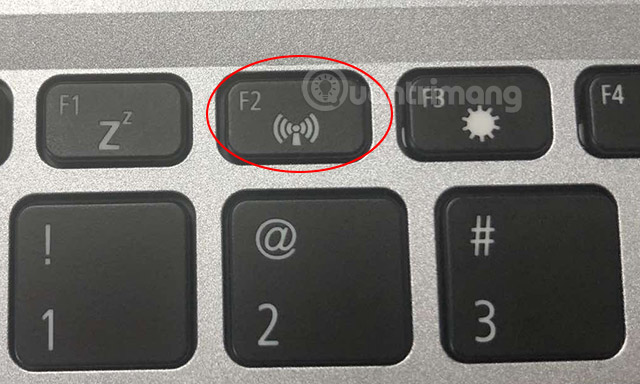
On Windows 10, you can enable airplane mode to quickly disconnect all connections when needed or when used on an airplane. Try checking if airplane mode on your laptop is turned on, by clicking on the notification center, and checking the airplane mode icon.
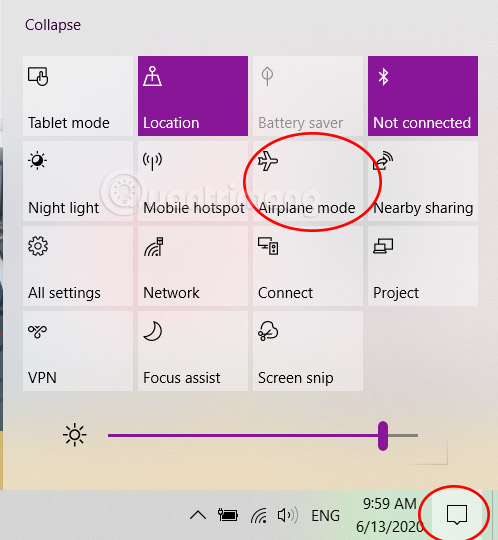
Airplane mode is a setting found on most mobile electronic devices - such as phones, tablets and laptops - that disables wireless transmitters such as cellular radios and WiFi on the device.
Depending on the manufacturer, airplane mode may also turn off Bluetooth and GPS. The main intention behind this feature is to eliminate the possibility of radio interference to critical systems on commercial aircraft. But there are some other reasons why you might need to use this feature from time to time.
On a Windows laptop, click the WiFi signal indicator to see and enable the airplane mode button. Airplane mode when activated will disable the WiFi signal. Depending on your device, airplane mode may also turn off Bluetooth and GPS.
Typically, manufacturers don't turn off Bluetooth because the network has such a short range and you're allowed to use Bluetooth devices like headsets and keyboards on commercial flights. And there's no practical reason for some manufacturers to turn off GPS, because GPS doesn't transmit at all; it simply receives and processes signals from the satellite.
While airplane mode turns off all those individual radios, you can still selectively turn specific wireless features back on even when airplane mode is activated. For example, if you're on a commercial flight with WiFi, you can turn it back on.
3. Check network settings in Control Panel
Go to Control Panel > Network and Sharing Center > Change adapter settings > find the WiFi network.
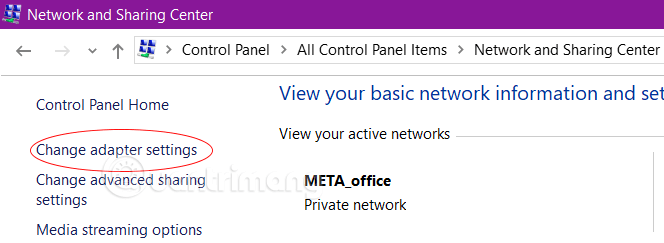
If you see it grayed out, right-click on it and select Enable to turn the WiFi network back on.
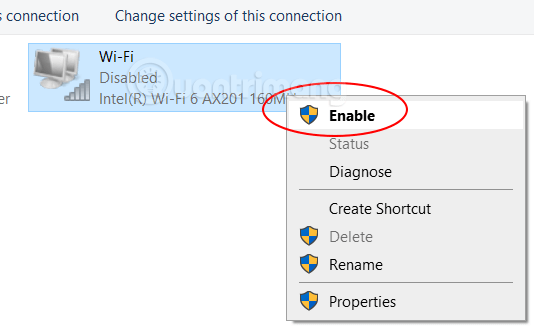
Also, if the WiFi network has a red x, you can try right-clicking on it, selecting Disable , wait a bit, then right-clicking again and selecting Enable again, sometimes this can be helpful.
4. Delete the WiFi network and reconnect
This method usually applies when your WiFi connection has a yellow exclamation mark or is limited.
Step 1: Click on the WiFi icon in the lower right corner of the Taskbar to open the list of WiFi networks.
Step 2: From the list above, identify the WiFi you want to delete and right-click on it. In the menu that appears, click Forget to forget/delete this network.
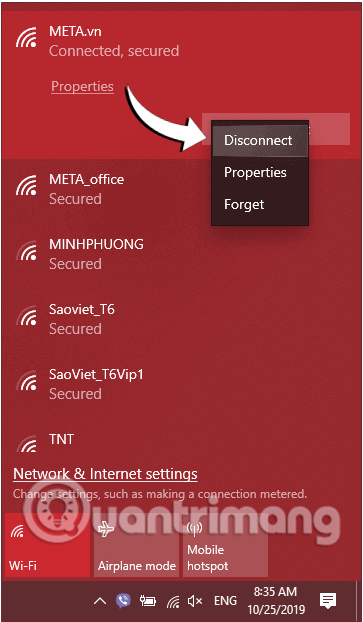
Step 3: That WiFi will be immediately removed from your computer. Now click on the WiFi icon and reconnect.
Step 4 : Please check to see if there are still errors or not!
Note : Try checking the list of available WiFi networks and see if any other trusted networks show up on the list. If so, connect to the network. If it shows 'Connected' then disconnect and reconnect to your desired network.
5. Reinstall the Wireless Network Adapter Driver
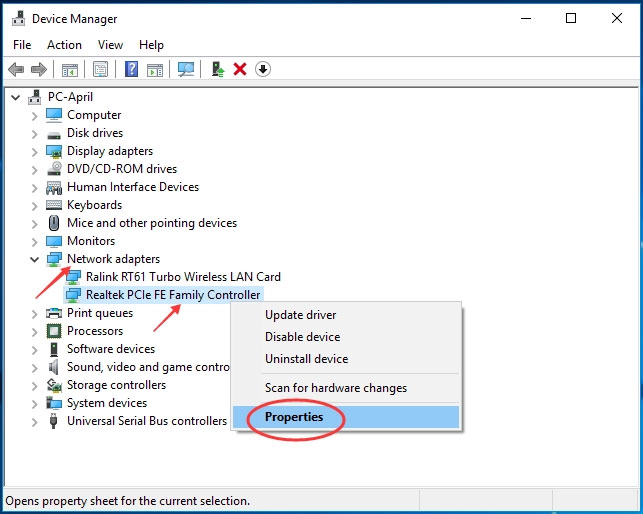
Reinstalling the network driver will clear the registry and reset all existing wireless configurations, which can help the laptop access the Internet via WiFi again. Here's how to reinstall your Wireless Network Adapter Driver
To do this, you will need to use Windows Device Manager to uninstall the wireless adapter before installing the driver.
1. Click Start , then enter Device Manager in the search box.
2. Double-click Device Manager to select it.
3. Double-click Network Adapters
4. If you have multiple adapters, a drop-down menu will appear listing them all. Right click on your WiFi Adapter and select Uninstall.
5. The Confirm Device Uninstall screen will appear. Click OK. Wait for the uninstallation process to complete. Make sure that the wireless adapter name is no longer displayed in the Network Adapters list .
6. On the Device Manager window , click Action. You can find the Action tab at the top between the File and View tabs. Select Scan For Hardware Changes from the drop-down menu.
7. The computer will reinstall the WiFi adapter and you will be able to see its name again.
8. Close all windows and restart the computer.
9. Try connecting to WiFi again. If the problem persists, continue reading.
6. Refresh IP address
Some cases that cause the error of not being able to connect to WiFi on a laptop are due to your device's IP address conflict. In this case, please refresh the IP and change to another IP range to fix the error. Here's how:
Step 1: Open Command Prompt, first enter cmdthe Seach Start Menu box or on the Taskbar, then right-click Command Prompt and select Run as administrator.
If you use Windows 10 with the latest versions, the Run as administrator button will appear as soon as you search for Command Prompt.
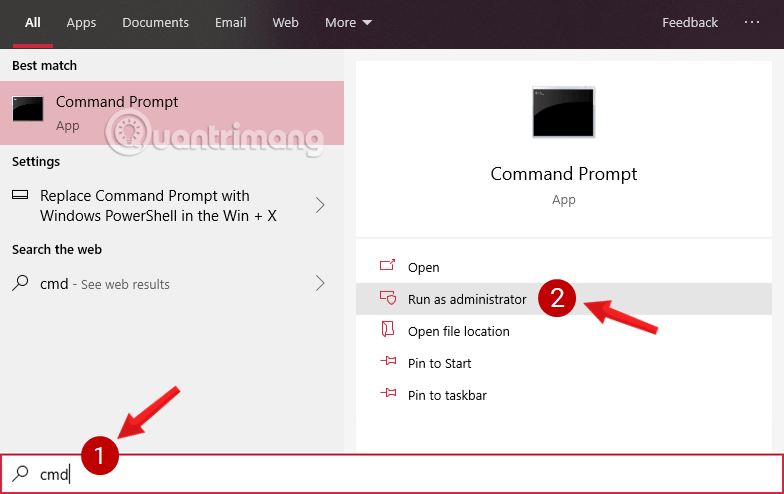
Click Yes if the User Account Control message appears on the screen.
Step 2: On the Command Prompt window , enter the command below and press Enter to delete the old IP that is failing:
ipconfig /release 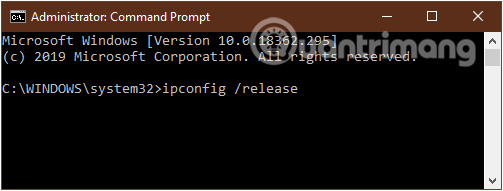
Step 3: Type the following command to have the computer receive the new IP range:
ipconfig /renewStep 4: Restart the computer for the system to note the changes.
7. Assign a static IP address
There is still a problem due to IP conflicts, overlapping addresses with another device on the LAN, this will cause one of the two machines to lose network or both. So try assigning a static IP address to your network.
TipsMake already has instructions on how to change a static IP for your computer, you can refer to it here: How to assign a static IP address in Windows 7, 8, 10, XP or Vista
8. Turn off Battery saving mode
Battery saving mode on computers has also been found to be one of the reasons why computers fail to connect to WiFi on laptops. So, try turning off this mode to see if it fixes it.
Step 1: Open the Run command window by pressing the key combination Windows+ R.
Step 2: Here you enter the following command and then click OK.
ncpa.cpl 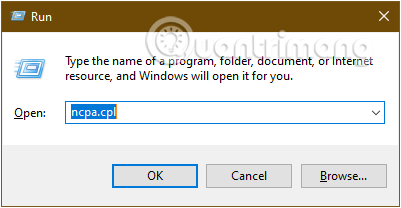
Step 3: The Network Connection window appears on the screen . Here you right-click on the WiFi you are using, select the Properties option.
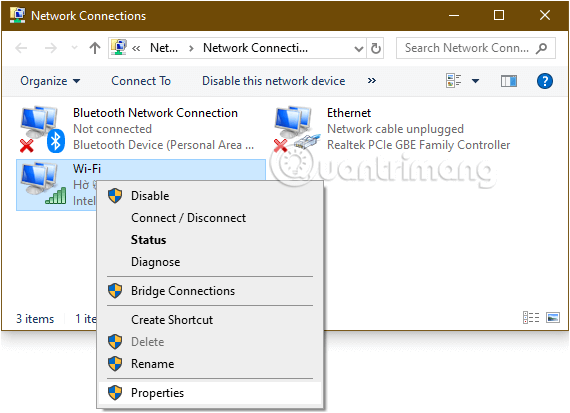
Step 4: At the Client for Microsoft Networks line , click Configure.
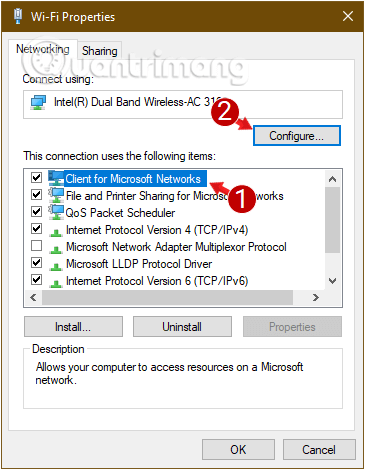
Switch to the Power Management tab and make sure Allow the computer to turn off this device to save power is unchecked .
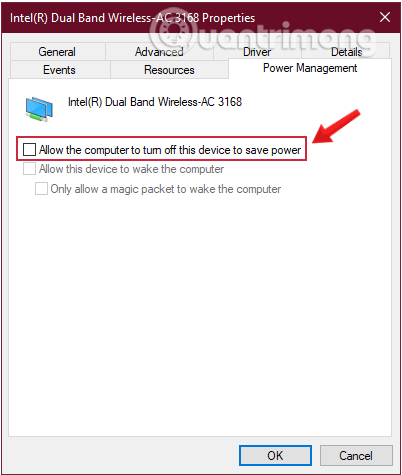
Step 5: Click OK and close Wi-Fi Properties.
If the WiFi still disconnects, follow the solution below.
9. Scan the entire computer for viruses
This is considered the most common reason for not being able to connect to the WiFi network on a laptop. The main reason is because you visit websites containing malicious code and use unsafe crack software but do not have an anti-virus program to protect your computer.
You can fix it by using a reliable antivirus program to scan the entire system.
Refer to the list of best anti-virus software at: Best anti-virus software for Windows today.
10. Disable VPN and other software
If you've checked everything else and still haven't found a solution, there's one more thing to consider. It's possible that one of the software you're running on the device is preventing the laptop from successfully connecting to the WiFi.
As mentioned before, VPN or Virtual Private Network is a fairly typical culprit in this case, as it changes your IP address.
Using a VPN on your PC has many advantages, but it also brings some problems. Although these problems are not very common, they can sometimes be annoying and difficult to fix. One of the problems that users often encounter is Wi Fi disconnection when VPN is enabled. As reported by many users, as soon as VPN is enabled on their PC, the Internet connection automatically stops working.
Enabling a VPN can affect various settings in your PC, so you can never be sure what exactly is causing it. Here are some possible scenarios:
- You are disconnected from the WiFi network you are connected to. Just go ahead and reconnect to the Wi Fi network and the problem will be fixed.
- As soon as the VPN is enabled, the WiFi card on your PC will be automatically disabled. Here, again, you can try to reconnect to your WiFi network by simply re-enabling the wireless network card manually. Usually there is a keyboard shortcut that does this.
- You cannot access the Internet after enabling VPN, even though your PC is connected to a WiFi network.
Now, you can easily reconnect your Wi Fi in some cases, but sometimes, it will take multiple solutions to get your Internet connection back. Try the solutions detailed in the following article: How to fix the error of not being able to connect to the Internet after connecting to a VPN.
But VPNs aren't the only software that can cause problems
Another potential culprit in this case is antivirus software or firewalls. If you set strict rules, this can even prevent your device from accessing the wireless network.
Temporarily disable your VPN, antivirus software, or firewall to see if this fixes your problem. If you determine that they are the cause of the problem, you can consider using other options instead or using the tools built into the operating system. TipsMake has some suggestions for you to consider:
11. Adjust WiFi location
In the living room, the WiFi signal is strong, but when you move to another room, losing the signal is a fairly common phenomenon. There are many reasons, wireless phones and devices using the 2.4GHz band can cause interference.
In addition, the glass mirrors in the room are also a cause. Therefore, it is necessary to check the objects next to the computer, check the antenna outside the router and also check for firmware updates for the router.
12. Reinstall Windows on the computer
If the above methods cannot fix the error, you may have to reinstall Windows from scratch to fix this problem. Rest assured that this solution will not lose data on your computer. However, to be more certain, you should still copy the contents of the folders and transfer them to an external hard drive.
This process will reset all your PC settings, it's just like a factory reset only it will keep your files.
You can refer to how to do it here: Reset Windows 10 to its original state
Besides, it may also be due to some browser errors, so try with all browsers on your computer. A faulty WiFi card is also a cause of computer loss of network. At that time, you should take your laptop to the store for repair and replacement.
One of the most annoying things you may have to deal with is your laptop not being able to connect to WiFi. This is true when you are at home, as well as when in public.
There is likely an easy solution that can solve your problem and in most cases, resetting both the laptop and the router is the quickest solution. However, in some cases, you may need to do more to fix this problem.
Above are some ways to fix laptop errors that cannot connect to WiFi. If there is a more effective way, please share with TipsMake by commenting below the article.
Good luck!
You should read it
- 12 tips to overcome file sharing issues
- Troubleshoot connectivity problems in the network - Part 5
- How to troubleshoot laptop lost Wi-Fi network
- Troubleshoot connectivity problems in the network - Part 6
- Troubleshoot Mac network problems
- Troubleshoot network connectivity problems (Part 2)
- How to troubleshoot Windows with Event Viewer log
- 5 steps to troubleshoot Wi-Fi network problems
May be interested
- Instructions to fix the error of not connecting to wifi on iPhone
 - iphone suddenly can't connect to wifi to interrupt the work? refer to the simple ways below.
- iphone suddenly can't connect to wifi to interrupt the work? refer to the simple ways below. - The most effective way to fix errors in computers and laptops that cannot connect to wifi
 there are many possible reasons why you cannot connect to wifi, the device reports a wifi error, or connects to the network. common fixes such as resetting the wifi modem or connecting to another wifi network can fix this problem. however, when the above methods are not effective, you can refer to the most effective ways to fix errors of computers and laptops not connecting to wifi compiled by tipsmake below.
there are many possible reasons why you cannot connect to wifi, the device reports a wifi error, or connects to the network. common fixes such as resetting the wifi modem or connecting to another wifi network can fix this problem. however, when the above methods are not effective, you can refer to the most effective ways to fix errors of computers and laptops not connecting to wifi compiled by tipsmake below. - Steps to fix Wi-Fi problems on Windows 11
 wi-fi connection on your windows 11 is intermittent, losing connection often? i will show you how to fix wi-fi problems on windows 11 very easily..
wi-fi connection on your windows 11 is intermittent, losing connection often? i will show you how to fix wi-fi problems on windows 11 very easily.. - Fix the WiFi connection of iPhone and iPad when on iOS 8
 a lot of customers complained about ios 8, especially the problem of battery drain and wifi connection or trouble, the daily life is slightly disturbed. while waiting for apple to thoroughly fix the redmondpie.com technology page, it gave a little trick to fix the wifi error currently encountered, if you have a similar situation, you should consult.
a lot of customers complained about ios 8, especially the problem of battery drain and wifi connection or trouble, the daily life is slightly disturbed. while waiting for apple to thoroughly fix the redmondpie.com technology page, it gave a little trick to fix the wifi error currently encountered, if you have a similar situation, you should consult. - Conflict of IP address error when connecting to Wifi on iPhone, iPad, this is a fix
 if you are unable to connect to websites or cannot download any applications, music ... to your device, you are most likely having an ip address conflict error when connecting to wi-fi. the cause of the error may be because more than one device on the same network has the same ip address.
if you are unable to connect to websites or cannot download any applications, music ... to your device, you are most likely having an ip address conflict error when connecting to wi-fi. the cause of the error may be because more than one device on the same network has the same ip address. - Instructions for fixing WiFi error with yellow exclamation mark - Common error when using Wifi network
 the error of wifi with a yellow exclamation mark is quite common in wifi devices, causing computers to not be able to catch wifi. this error occurs when ip conflicts or a large number of people connecting to wifi lead to a limited network.
the error of wifi with a yellow exclamation mark is quite common in wifi devices, causing computers to not be able to catch wifi. this error occurs when ip conflicts or a large number of people connecting to wifi lead to a limited network. - 5 ways to fix Windows 10 can not connect to WiFi error
 connecting to wifi but not being able to access the network is one of the most frustrating things about using windows. how to fix the above situation?
connecting to wifi but not being able to access the network is one of the most frustrating things about using windows. how to fix the above situation? - Fix Wifi error disconnected on Windows 10, 8, 7 and Vista
 have you ever had a laptop disconnect from your wireless network continuously? or after upgrading the computer to windows 10 (or windows 8, 8.1) operating system, your wifi connection is disconnected.
have you ever had a laptop disconnect from your wireless network continuously? or after upgrading the computer to windows 10 (or windows 8, 8.1) operating system, your wifi connection is disconnected. - How to fix the problem of not connecting to WiFi in Windows 10
 having a network connection is very important because a lot of the work depends on a stable internet connection. there can be a variety of reasons why your connection is not working properly, and these problems can be easily resolved.
having a network connection is very important because a lot of the work depends on a stable internet connection. there can be a variety of reasons why your connection is not working properly, and these problems can be easily resolved. - Fix the problem of unstable WiFi on laptop with Windows 8.1 installed
 currently, there are some older laptops after upgrading from windows xp to windows 8.1 often have problems connecting to wifi, even if they have installed driver. this situation even occurs when you have reinstalled windows. this article will guide you how to fix wifi instability and glitches on laptop using windows 8.1.
currently, there are some older laptops after upgrading from windows xp to windows 8.1 often have problems connecting to wifi, even if they have installed driver. this situation even occurs when you have reinstalled windows. this article will guide you how to fix wifi instability and glitches on laptop using windows 8.1.






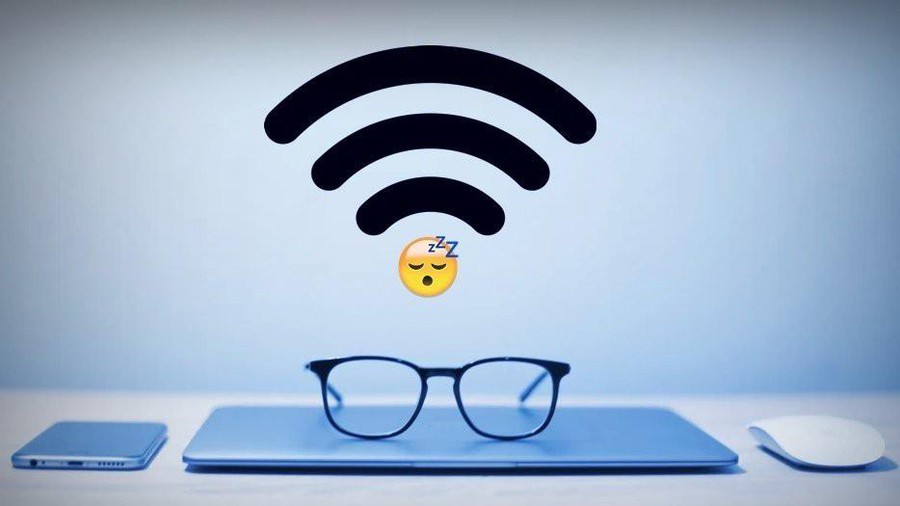



 Some ways to improve Wi-Fi connection and speed up WiFi
Some ways to improve Wi-Fi connection and speed up WiFi What is 1.1.1.1? How does it speed up the Internet and secure data when browsing?
What is 1.1.1.1? How does it speed up the Internet and secure data when browsing? How to create WiFi Hotspot in Ubuntu
How to create WiFi Hotspot in Ubuntu How to turn an old router into a wireless bridge
How to turn an old router into a wireless bridge 6 best DNS servers to improve online safety
6 best DNS servers to improve online safety 5 reasons to upgrade to a Wi-Fi 7 router
5 reasons to upgrade to a Wi-Fi 7 router